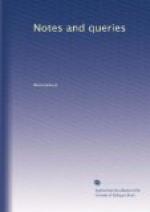“It is reported the
Chinese have had the use of tobacco for many
ages,” &c.—Travels,
vol. ii. p. 73., Lond. ed. 4to. 1763.
Ledyard says, the Tartars have smoked from remote antiquity (Travels, 326.). Du Halde speaks of tobacco as one of the natural productions of Formosa, whence it was largely imported by the Chinese (p. 173. Lond. ed. 8vo. 1741).
The prevalence of the practice of smoking at an early period among the Chinese is appealed to by Pallas as one evidence that in Asia, and especially in China, the use of tobacco for smoking is more ancient than the discovery of the New World. (See Asiat. Journ., vol. xxii. p. 137.)
The Koreans say they received tobacco from Japan, as also instructions for its cultivation, about the latter end of the sixteenth century. (Authority, I think, Hamel’s Travels, Pink. Coll., vii. 532.) Loureiro states that in Cochin China tobacco is indigenous, and has its proper vernacular name.
Java is said to have possessed it before 1496. Dr. Ruschenberg says,
“We are informed the
Portuguese met with it on their first visit
to Java.”—Voy.
of U.S.S. Peacock, vol. ii. p. 456, Lond.
ed.
8vo. 1838.
Crauford dates its introduction into Java, 1601, but admits that the natives had traditions of having possessed it long before. (Indian Archipelago, vol. i. pp. 104. 409, 410. 8vo.) Rumphius, in the latter part of the seventeenth century, found it universal even where the Portuguese and Spaniards had never been.
Savary, in his Parfait Negociant, states that the Persians have used tobacco 400 years, and probably received it from Egypt. (See Med. Chir. Review, 1840, p. 335.)
Olearius found it fully established in Persia, 1637, only about fifty years after its arrival in England. (Lond. 1662, in fol. p. 322.) Chardin states, the Persians smoked long before the discovery of America, and had cultivated tobacco time immemorial.
“Coffee without tobacco
is meat without salt.”—Persian Proverb,
Sale’s Koran,
Preliminary Discourse, 169. ed. 8vo.
In 1634 Olearius found the Russians so addicted to tobacco that they would spend their money on it rather than bread. (See edit. above quoted, lib. iii. p. 83.)
According to Prof. Lichtenstein, the Beetjuanen smoked and snuffed long before their intercourse with Europeans. (Med. and Chir. Rev., 1840, p. 335.)
Liebault, in his Maison Rustique, asserts that he found tobacco growing naturally in the forest of Ardennes. Libavius says that it grows in the Hyrcinian forest. (Ibid.)
Dr. Cleland shows the three last to be falsehoods(?).
Ysbrants Ides found tobacco in general use among the Ostiaks and other tribes passed in his route to China, 1692. (Harris’s Coll., fol. vol. ii. pp. 925. and 926.)




